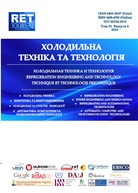CONVECTIVE HEAT EXCHANGE FROM THE REFRIGERATING CONTAINER REFRIGERATION UNIT EVAPORATOR SURFACE PROBLEM SIMULATION
DOI:
https://doi.org/10.15673/0453-8307.4/2015.44786Keywords:
Simulation, Refrigerating container, Refrigeration unit, Evaporator, Forced convection, Rate vectorAbstract
The study is aimed at solving the problem of convective heat transfer calculating in the tubular evaporator unit of refrigerating container, which is equipped with fan forced convection. The mathematical model of the problem as a differential equation that establishes the energy conservation law in the air cells through the surface of which its movement is carried out is given. Inthe process of the convective heat transfer around the evaporator problem calculating the link between the basic physical quantities in the air − temperature fields and velocity of its movement was considered. Close relationship of obtained temperature values and air velocity at the outlet from evaporator unit as boundary conditions for further calculation of temperature field in the refrigerator compartment of refrigerating container was proved. Statement of the problem and its simulation wereperformed in a two-dimensional coordinate system, and software environment COMSOL Multiphysics, Femlab 3.0, Fluid Dynamics - Incompressible Navier-Stokes - Convection and Conduction was applied for its solution. he accomplished calculations have shown that the integral temperature value at the outlet of the evaporator unit, was calculated taking into account air velocity, which is lower than its values obtained without air movement consideration. The results of the study should be useful during the research of the convective heat transfer phenomenon in the different refrigerating devices, allow to choose evaporator and fan capacity morereasonably under conditions of obtaining the desired cooling mode for perishable products as well asin the learning processReferences
Belyaev N.М. 1989. Оsnovy teploperedachi: Uchebnik. Кyiv.: Vyscha shkola. Golovnoe izd-vo, 343 p.
Gresho, P.M, and Sani, R.L. 2000. Incompressible Flow and the Finite Element Method, Volume 1 & 2, John Wiley & Sons, New York.
Pironneau,O. 1989. Finite Element Methods for Fluids, John Wiley & Sons.
Rose, Alan, and Simpson, Ben. 2000. Laminar, Constant-Temperature Flow Over a Backward Facing Step. 1st NAFEMS Workbook of CFD Examples. Glasgow, UK.
Downloads
Published
2015-06-21
Issue
Section
Refrigeration engineering


